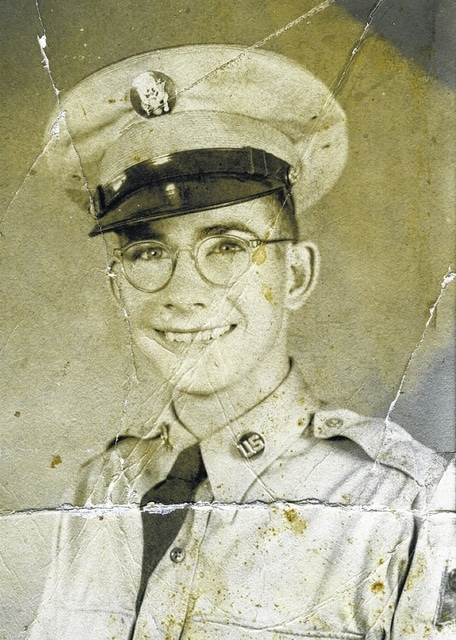


Editor’s note: This is one of a series of articles that will run until Labor Day in advance of the return to Sidney of the Vietnam Memorial replica wall and a Field of Valor featuring American flags in Custenborder Park. Both exhibits are by the Shelby County Historical Society. Flags for the Field of Valor can be purchased by calling 498-1653. The project commemorates 2015 as the anniversary of the beginning or end of several U.S. armed conflicts. This series will include stories about most of America’s wars. Today, a veteran shares his memories of the Korean Conflict.
ANNA — Anna residents probably know Ralph Copeland, 85, as a foot-race runner, jogger and walker.
He’s enjoyed walking and running around town for decades. But before he settled in Anna, Copeland had marching, not running orders. He served in the U.S. Army during the Korean conflict.
A Sidney native, he left Sidney High School to join the military in 1949. Following basic training at Fort Knox, Kentucky, Copeland took a train to the west coast and then shipped out to Japan.
“When I was in Japan, it was to keep track of where all the Army equipment was,” he said recently. “I worked in the accountable office.”
He had been there for about a year, when war broke out in Korea.
The northeast Asian country had been divided as the spoils of war following Japan’s defeat by the Allies in World War II. The Soviet Union took control of the North Korea. The United States supported South Korea. In June 1950, Soviet-backed troops swarmed south across the 38th parallel, which was the boundary between the two countries. The U.S. sent troops to back South Korea in July. Copeland’s unit moved there in 1951.
“We were stationed pretty much around Seoul,” Copeland said. Attached to the famous 1st Cavalry Division, his unit was responsible for keeping the front lines supplied. Never in battle himself, he had to deal with occasional artillery fire and air attacks.
“Bed-check Charlie,” he said. The term was coined during World War II to signify solitary enemy planes that harassed Allied bases.
The most difficult thing Copeland had to cope with was the weather.
“The freezing winter,” he said, “it was dead cold. We had layered clothing that kind of helped you stay warm, but evertually, you got cold.” Most of his work was done outside. Sleeping quarters were tents or bombed-out buildings. As the front lines moved forward, so did the supply lines behind them. At one point, Copeland found himself near the 38th parallel, which served as the boundary between North and South Korea and is now in the demilitarized zone.
“I don’t remember why,” he said. “A big mistake, I think. The whole unit was there. We weren’t supposed to be.”
The Americans with whom Copeland served did not have many occasions to interact with Koreans.
“If you ran into them, they acted like they didn’t have a tendency to want to talk,” he said. But he did get to know a Filippino scout who assisted the Army.
“They’re a lot different than what we are,” Copeland said. “He caught a baby squid and just started pulling the legs off and eating it.”
U.S. news outlets didn’t give a lot of coverage to the Korean conflict, so many people even today don’t know much about it. The popular television program, “M.A.S.H.,” was set there, but Copeland wasn’t a fan.
“It’s all about Korea, but it’s not a good portrayal,” he said. His only experience with a medical unit was seeking treatment for a bad cold.
Following his time in Korea, he spent three months at Camp Kilmer, New Jersey, before returning to Sidney.
“I went to see my dad and he gave me a big hug. He wasn’t sure I was going to get to come home,” Copeland said. He has never returned to Korea.
“I’m happy to see that South Korea rebuilt. When we were there it was a bombed-out mess,” he said. “They had really nice buildings there and they were destroyed. I snagged me a Russian carbine. I wanted to bring it back. Customs wouldn’t let me. I couldn’t even bring my M-1 back.”
Copeland was discharged from the Army in 1952 and re-enlisted in 1955. He served until 1958 and was sent to Frankfort, Germany, where he was a security guard at an office building in which military information was kept.
“I made sure nobody stuck their nose in there that shouldn’t be there,” he said.
Following his Army days, Copeland worked for a number of area industries, including Monarch and Stolle. He retired at 62 from Western Ohio Packaging. Besides racing, he enjoyed bowling.
“I was a jack of all trades,” he said. “My brother, Gene, introduced me to Anna and pretty soon, wedding bells started ringing.” Ralph and Anna, who was 23 years his junior, were married in 1975 and raised four children, John, Donald, Tina, and Alisha, now all of Anna. Copeland has five grandchildren and three great-grandchildren. His wife died last year.
As he looks back now, he’s glad he lived through the war.
“I don’t like the fact that we lost a lot of our soldiers over there,” he said.
Reach the writer at 937-538-4824. Follow her on Twitter @PASpeelmanSDN.

